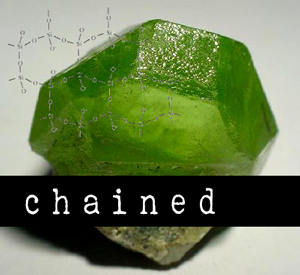

Despite its name, there is no bronze in bronzite. Iron oxide is between 12% and 30%, and separation of the iron oxide along cleavage lines is the source of the metallic sheen. It is a mineral variety of enstatite rather than a unique mineral itself. It's found in igneous rocks and meteorites, like olivine (peridot).
Chrome diopside tends to be the mineral used in jewelry, for it's brilliant green color. It was discovered in 1988 in Russia's Eastern Siberia, and some deposits have been found in Pakistan. Diopside is typically opaque, and transparent stones with deep color are rare and therefore valuable. It can appear as deeply green as green tourmaline or emerald, but it is softer than either mineral and more prone to scratching. It requires no treatment to enhance or keep its bright rich color.
The two minerals of "jade" are shown in the grid-item. Nephrite tends to be darker green with a silky or lustrous appearance. Jadeite can be a range of colors, including green that rivals nephrite jade, hence their confusion for many years. Gem-quality jadeite is sometimes called imperial jade, and it tends to show more blotchy inclusions. Both stones have been revered for their beauty; nephrite is prized in Chinese culture and jadeite was used extensively in Mesoamerican art and ornament (Aztec, Maya, Pueblo Indians).
Kunzite was first discovered in Connecticut by George Kunz, a former vice president and buyer for Tiffanys. Most of the current supply comes from Afghanistan and Pakistan. As a gemstone, it gained popularity following the 1996 Sotheby's auction of the Estate of Jacqueline Kennedy Onassis in which a 47 carat kunzite ring was sold for $410,000. It was intended to be a 1963 Christmas present from President Kennedy to his wife, but tragically he was assassinated that November. The stone is untreated, and the color may naturally fade with time and exposure to light. Inclusions are common, and the more valuable specimens are clear to the eye.
Peridot was considered a symbol of the sun from ancient times through the Middle Ages, and it was long used in jewelry and ornamentation. It is widespread, though Pakistan is the principal source for gem-quality stones. In the presence of water at low temperatures, olivine readily transforms to other minerals like serpentine or magnetite, which is why it's more likely to find peridot in dry climates or in areas with recently formed rocks.
Rhodonite takes its name from the Greek rhodon meaning "rose". It's most commonly opaque and usually used as cabachons or smooth polished beads in jewelry. It is often streaked with black veins (black manganese oxides), and matrix rhodonite can be more valuable than plain rhodonite. In 1979 it was designated the state gem stone of Massachusetts.